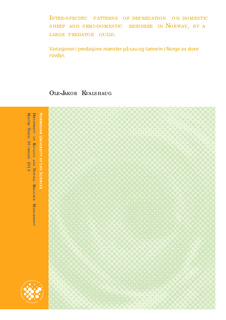| dc.description.abstract | Livestock depredation by large predators is the main cause of human-wildlife conflicts in Norway. The depredation on free-ranging semi-domestic reindeer (Rangifer tarandus) and domestic sheep (Ovis aries) can have severe economic impact on individual livestock owners. The losses are as a result fully compensated by the Norwegian government. Using data on documented losses livestock collected from a national database (Rovbase 3.0) in the period 2003 to 2011, I compared the depredation patters of the different predator species in northern Norway: lynx (Lynx lynx), wolverines (Gulo gulo), brown bears (Ursus arctos), wolves (Canis lupus) and golden eagles (Aquila chrysaetos). I investigated if there were any preferences by the multiple predators for age class (young or adult) and sex class (female or male) in the two livestock species, and if there was a relationship between a mean body weight of each predator species and the proportion of young and adult prey killed. I also investigated if there was a seasonal difference in the depredation of the five predator species. The standing population of reindeer and sheep was estimated using data from the Norwegian Reindeer Authority and Statistics Norway. The reindeer material was divided in a summer and a winter population, and the summer dataset was compared with the sheep dataset.
I found that juvenile livestock were preferred as prey by the majority of predator species, and only when brown bears depredated on sheep, a predator species showed a significant preference for adults. I also found that age selection within the sheep population correlated with the mean body weight of each predator species, meaning that the proportion of ewes killed increased with the body weight of the predator. My thesis provides an insight in the ecology of livestock depredation in a multiple predator system. One can see some clear trends in predation. Still, some kills are probably more underrepresented than other, depending on the age class of the kill and the difference in predator behavior. Estimating total kills based on documented kills are thus uncertain. Instead of using resources to locate and document individual kills, more effort should be put in place to estimate the population size of both predators and prey and to investigate the actual predation rate and preference of age and sex of each predator species. A compensation system based on such estimates could be preferred both from the management and the husbandry | no_NO |
